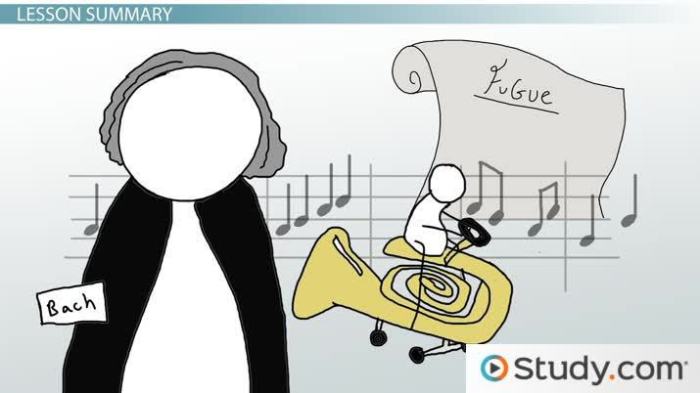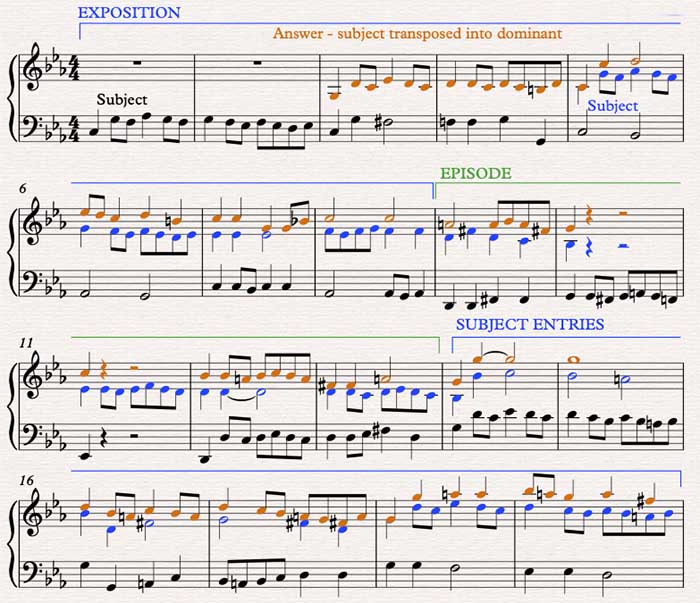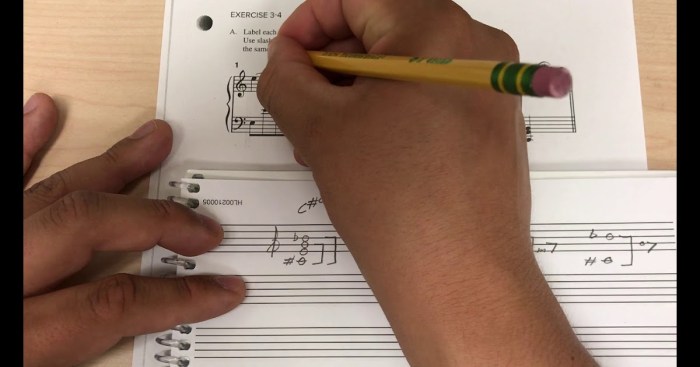Partner of a fugue often – In the intricate tapestry of music, the partner of a fugue emerges as a pivotal element, enhancing harmony and shaping the formal structure of this captivating musical form. From its historical origins to its profound influence on musical development, we embark on an engaging exploration of the partner’s role in shaping the fugue’s melodic and harmonic landscape.
The partner, an integral companion to the fugue, complements and supports its thematic material, creating a dynamic interplay that enriches the overall composition. Its presence contributes to the fugue’s formal structure, influencing its development and resolution.
Fugue in Music

A fugue is a contrapuntal composition in which a main theme, known as the subject, is introduced and then imitated by other voices in succession, creating a complex and interwoven musical texture. Fugues have been a staple of Western classical music since the Baroque period, and they continue to be composed and performed today.The
origins of the fugue can be traced back to the 16th century, when composers began experimenting with imitative counterpoint. The first known fugues were written by Flemish composers such as Josquin des Prez and Orlando di Lasso. By the 17th century, the fugue had become a standard form in instrumental music, and it was widely used by composers such as Johann Sebastian Bach, George Handel, and Wolfgang Amadeus Mozart.Fugues
are typically written in three or four voices, and they can be either tonal or atonal. Tonal fugues are based on a specific key, and they use the principles of harmony to create a sense of tension and release. Atonal fugues, on the other hand, do not have a specific key, and they use dissonant harmonies to create a more complex and challenging listening experience.Some
of the most famous fugues in music include Bach’s “Fugue in D Minor” from The Well-Tempered Clavier, Handel’s “Fugue in G Minor” from the Water Music, and Mozart’s “Fugue in C Minor” from the Fantasia in C Minor. These fugues are considered masterpieces of the genre, and they continue to be studied and performed by musicians around the world.
Partner of a Fugue
The partner of a fugue is a contrasting theme that is introduced after the initial exposition of the fugue’s subject. The partner typically provides a harmonic and melodic contrast to the subject, and it often serves to develop and extend the fugue’s musical material.The
partner can play a variety of roles in a fugue. In some cases, the partner may be used to create a contrasting section within the fugue, providing a sense of balance and variety. In other cases, the partner may be used to develop the fugue’s subject, providing new melodic and harmonic possibilities.There
are several different types of partners that can occur in fugues. Some of the most common types of partners include:*
-*Answering partner
A fugue’s partner is often a quiet and unassuming figure, providing support and harmony to the more prominent melody. In a similar vein, the pathway by Chick-fil-A offers a serene and inviting backdrop for leisurely strolls or intimate conversations. Like the partner of a fugue, it complements and enhances the experience without overshadowing the main attraction.
An answering partner is a partner that is based on the fugue’s subject, but which is transposed to a different key.
-
-*Contrapuntal partner
A contrapuntal partner is a partner that is independent of the fugue’s subject, but which is written in a contrapuntal style.
-*Episodic partner
An episodic partner is a partner that is not based on the fugue’s subject, and which is typically written in a more homophonic style.
The partner of a fugue is an important element of the fugue’s overall structure and development. The partner provides a contrasting theme that helps to create a sense of balance and variety, and it can also be used to develop and extend the fugue’s musical material.
Harmonic and Melodic Relationship

The partner of a fugue, often referred to as the countersubject, plays a crucial role in enhancing the harmonic and melodic complexity of the fugue. It provides a complementary melodic line that interacts with the fugue’s subject, creating a rich and intricate musical tapestry.
Complementary Melodic Lines, Partner of a fugue often
The countersubject is designed to contrast with the subject in terms of melodic contour and rhythmic patterns. This contrast creates a sense of tension and release, adding interest and depth to the overall composition. The melodic lines of the subject and countersubject often intertwine, creating a complex web of voices that showcase the composer’s skill in counterpoint.
Harmonic Support
In addition to its melodic function, the countersubject also provides harmonic support to the fugue’s subject. It often Artikels the harmonic structure of the piece, providing a foundation upon which the subject can develop. The interaction between the subject and countersubject creates a sense of harmonic progression, adding depth and richness to the musical texture.
Examples of Effective Partnerships
Many fugues throughout history have showcased particularly effective partnerships between the fugue and its countersubject. Some notable examples include:
- Johann Sebastian Bach’s “Fugue in D Minor” (The Well-Tempered Clavier, Book 1): The countersubject in this fugue provides a strong harmonic foundation and creates a sense of tension and release with its contrasting melodic line.
- Wolfgang Amadeus Mozart’s “Fugue in C Minor” (K. 426): The countersubject in this fugue is a lively and playful melody that complements the subject’s more serious character, creating a delightful and engaging musical experience.
Formal Structure and Interaction

The partner in a fugue plays a crucial role in shaping the overall formal structure of the piece. It provides a contrasting thematic material and a harmonic framework against which the fugue’s subject and countersubjects can be developed and elaborated.
The interaction between the fugue and its partner can take various forms, including:
Exposition
- In the exposition, the partner typically enters after the fugue’s subject has been presented. It may provide a contrasting harmonic context or a counterpoint to the subject.
- For example, in Bach’s “Fugue in D Minor” (BWV 539), the partner enters with a descending chromatic line that contrasts with the subject’s ascending stepwise motion.
Development
- During the development section, the partner interacts with the fugue’s subject and countersubjects in various ways.
- It may provide harmonic support, act as a counterpoint, or engage in imitative entries with the fugue’s thematic material.
- For instance, in Beethoven’s “Fugue in B-flat Major” (Op. 133), the partner frequently engages in imitative counterpoint with the fugue’s subject, creating a dense and complex texture.
Recapitulation
- In the recapitulation, the partner typically reappears in its original form, providing a sense of closure to the fugue.
- It may also interact with the fugue’s subject and countersubjects in a similar manner to the exposition.
- For example, in Handel’s “Fugue in G Minor” (HWV 605), the partner returns in the recapitulation with the same harmonic and melodic material as in the exposition, reinforcing the overall structure of the fugue.
Influence on Musical Development: Partner Of A Fugue Often

The partner of a fugue has played a pivotal role in shaping the evolution of musical forms. Initially, the partner served as a simple harmonic accompaniment to the fugue subject, providing a harmonic foundation for the melodic lines.
Over time, the partner’s role became more elaborate, contributing to the overall development of the fugue’s texture and form. In later compositions, the partner often took on a more active role, engaging in contrapuntal interactions with the fugue subject.
Evolution of the Partner’s Role
The evolution of the partner’s role can be traced through the works of various composers. In early fugues by composers such as Johann Sebastian Bach, the partner typically played a subordinate role, providing a harmonic foundation for the fugue subject.
However, in later works by composers such as Wolfgang Amadeus Mozart and Ludwig van Beethoven, the partner became more active, engaging in contrapuntal interactions with the fugue subject. This development led to a more complex and intricate fugue texture.
Influence on Musical Forms
The partner of a fugue has had a significant influence on the development of various musical forms, including the fugue itself. The partner’s role in providing harmonic support and contrapuntal interaction has contributed to the fugue’s unique character and structure.
Additionally, the partner’s role has influenced the development of other musical forms, such as the sonata and the symphony. In these forms, the partner often plays a similar role, providing harmonic support and contrapuntal interaction for the main melodic themes.
Examples of Influential Fugues
Numerous fugues throughout musical history have had a significant impact on the development of music. Some notable examples include:
- The Well-Tempered Clavierby Johann Sebastian Bach: This collection of 48 fugues and preludes is considered one of the most important works in the history of music. The fugues in this collection showcase a wide range of textures and forms, demonstrating the versatility of the fugue form.
- The Art of Fugueby Johann Sebastian Bach: This unfinished work is a collection of 14 fugues and canons that explore the possibilities of the fugue form. The work is considered a masterpiece of contrapuntal writing and has had a profound influence on the development of music theory.
- Fugue in D Minorby Wolfgang Amadeus Mozart: This fugue is known for its dramatic and intense character. The fugue subject is presented in a powerful and assertive manner, and the partner provides a contrasting and supportive harmonic foundation.
FAQ Insights
What is the primary function of the partner in a fugue?
The partner provides harmonic and melodic support to the fugue’s thematic material, enhancing its overall musicality.
How does the partner contribute to the formal structure of a fugue?
The partner helps define the fugue’s sections and contributes to its overall shape and development.
Can you name a famous fugue with a particularly effective partnership?
Bach’s “Fugue in D Minor from The Well-Tempered Clavier, Book 1” showcases a masterful partnership that enhances the fugue’s harmonic and melodic complexity.
